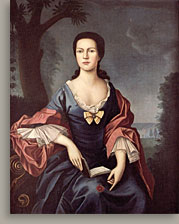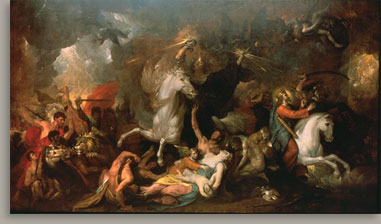| Benjamin West Born Springfield, Penn., October 10, 1738. Died London, March 11, 1820. Benjamin West developed from a precocious but provincial artist in colonial Pennsylvania to the official painter at the court of King George III and the president of the Royal Academy in London. Best known for his history paintings, West was also a prolific portraitist and an occasional painter of landscapes. His total catalogued output numbers more than seven hundred paintings, for many of which he made preliminary drawings. West's style progressed from an early interest in the baroque and rococo to a neoclassical and finally a romantic style. His American birth and preeminent place in the British art world at the end of the eighteenth century made him the person to whom three generations of aspiring American artists turned for guidance, encouragement, and training. Although West never returned to North America, through his students he had a major impact on American art. West was born in Springfield, Pennsylvania, a predominantly Quaker community near Philadelphia. He received his first art instruction in 1747 from the English emigrant William Williams (1727–1791), a portraitist who worked briefly in Philadelphia.1 West also learned through observing the works of the American itinerant artist Robert Feke (about 1707–about 1751), the English rococo painter John Wollaston, and the Swedish native Gustavus Hesselius (1682–1755) and his son John (about 1728–1778). From an early age West received patronage from prominent Pennsylvanians, including the Allen and Mifflin families in Philadelphia and the Ross family in Lancaster.2
West's most important early encouragement came from the Reverend William Smith, who was the provost of the College of Philadelphia (now the University of Pennsylvania). Smith introduced West to portrait customers, promoted West in the contemporary press, and in 1760 helped him travel to Italy, where his exposure to a lively contemporary art scene and the example of old master paintings greatly enhanced his abilities.6 West arrived in Leghorn, Italy, and proceeded to Rome, where he met the German artist Anton Raphael Mengs (1728–1779), the Scottish painter Gavin Hamilton (1723–1798), and the Englishman Nathaniel Dance (1735–1811). West's paintings demonstrate that he improved rapidly and dramatically in Italy. His models now included the works of Mengs, the stylish Italian portraitist Pompeo Batoni (1708–1787), and the Renaissance master Raphael.7 In addition to a handful of portraits, West also painted six copies after Old Master paintings for the Philadelphia patrons who paid for his trip to Italy. In Venice West met Richard Dalton, the British royal librarian, who commissioned on behalf of George III a painting called Cymon and Iphigenia (1762, location unknown), based on an episode in Giovanni Boccaccio's Decameron. That commission provided the first step in West's thirty-year-long association with the British court.8 In 1763, traveling by way of France, West moved to London. The following spring he exhibited at the Society of Artists in London, and his success prompted him to remain there. When it became clear that West would remain in England, his fiancée, Elizabeth Shewell, joined him there, and the couple was married in London on September 2, 1764. West's marriage inaugurated another tradition that would continue throughout his life. Shewell arrived in London with her cousin Matthew Pratt, who became the first of West's many American pupils.9 The following year Pratt memorialized West's role as a teacher in his painting The American School (1765, Metropolitan Museum of Art, New York). In the coming years, West would advise by correspondence John Singleton Copley and teach firsthand Charles Willson Peale, Gilbert Stuart, Ralph Earl, John Trumbull (1756–1843), and Washington Allston (1779–1843), among others.10 Although West continued to paint portraits into the 1780s, his work as a history painter became increasingly important in the mid–1760s. West's Paetus and Arria (1766, Yale Center for British Art, New Haven, Conn.), based on a story recorded by Pliny the Younger places the subjects in a geometrically ordered shallow space and heralds a shift in his work toward neoclassical clarity.11 West continued to paint subjects from Roman antiquity and borrowed from such classicizing old masters as Raphael (1483–1520) and Nicolas Poussin (1594–1665). One of the defining canvases of this period was Agrippina Landing at Brundisium with the Ashes of Germanicus (1768, Yale University Art Gallery, New Haven, Conn.), which foregrounds the returning widow at the center of a stagelike setting that West derived from the work of the neoclassical architect Robert Adam (1728–1792). The painting of Agrippina earned the admiration of George III, who extended to West his first direct royal commission.12 West would eventually paint approximately sixty portraits and history paintings for the king. In 1780 George III began to pay West an annual stipend of one thousand pounds, marking the beginning of West's self-presentation as "Historical Painter to the King of England." West maintained this status officially until 1810, when the king was incapacitated by mental illness. Between 1779 and 1801 West worked on his most ambitious cycle of paintings-a series of canvases representing "the progress of Revealed Religion, from its commencement to its completion" for the royal chapel at Windsor.13 This project was to be West's greatest contribution to the history of religious painting, but the chapel decoration was never completed due to repeated changes in the organization of the interior and the sheer magnitude of the undertaking.
In addition to his neoclassicism and realism, West adopted a romantic style in the 1780s that was well-suited to sublime subject matter. This new style emerged in the context of West's designs for such biblical works as Saul and the Witch of Endor (1777, Wadsworth Atheneum, Hartford, Conn.) and such literary paintings as King Lear in the Storm (1788, Museum of Fine Arts, Boston). The romantic strategies of representing darkness and tumultuous motion also proved helpful in depicting a number of designs for the royal chapel at Windsor, including Pharaoh and His Lost Host in the Red Sea. West's romanticism culminated in the grand-scaled Death on the Pale Horse (fig. 3). The apocalyptic scene was taken from Rev. 6:1-11 and represents the death and disease that are said to accompany, as the original subtitle of the painting says, "the Opening of the First Five Seals."15 Like other history painters of the period, West capitalized on this late work by charging admission and presenting it as a spectacle.
West died in 1820, and the following year his sons established an art gallery in his honor. They initially displayed ninety-four of West's paintings, including many of the ones he had made for George III's never-completed chapel of revealed religion.17 West's sons tried unsuccessfully in 1826 to sell the collection to the United States government and three years later dispersed the paintings by auction.
Notes 2. Von Erffa and Staley 1986, for Allen family patronage, see 484–86; for Mifflin family, see 532-34; and for Ross, see 548-51. 3. For an illustration of Haecken's print, see Sellers 1957, 437. 4. Von Erffa and Staley 1986, 2, 450. 5. Ibid., 11, 444. 6. Ibid., 7, 9, 13, 21, 23. 7. Ibid., 14, 17, 19. 8. Ibid., 23, 264–65. 9. Evans 1980, 24. 10. For a full discussion of West's role as the most important teacher of American artists in the late colonial and early national periods, see Ibid. 11. Von Erffa and Staley 1986, 38–40, 182. 12. Ibid., 44–50, 179–80. 13. For a thorough treatment of West's paintings for the chapel at Windsor, see Meyer 1975, Pressley 1983, and Von Erffa and Staley 1986, 577–81. 14. Abrams 1985, 161–84; Von Erffa and Staley 1986, 211–14, quote 213. 15. Von Erffa and Staley 1986, 142–50, 388–92. 16. For the rivalry between West and Copley at the Royal Academy, see Prown 1966, II, 337–39, 365–67, 374–75. 17. Von Erffa and Staley 1986, 150, 160–61. |



